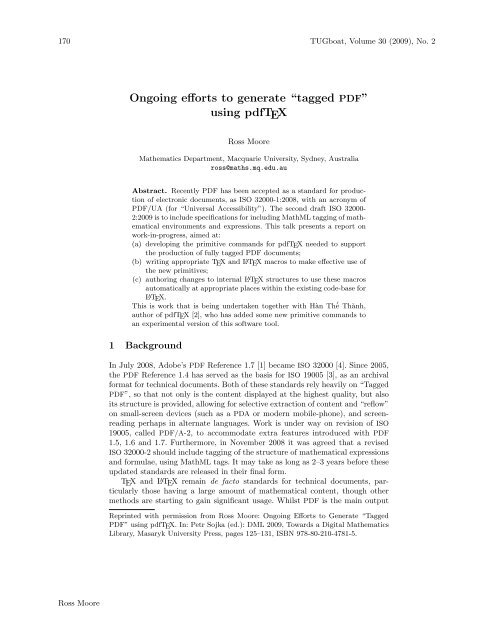The Communications of the TEX Users Group Volume 30 ... - TUG
The Communications of the TEX Users Group Volume 30 ... - TUG
The Communications of the TEX Users Group Volume 30 ... - TUG
Create successful ePaper yourself
Turn your PDF publications into a flip-book with our unique Google optimized e-Paper software.
170 <strong>TUG</strong>boat, <strong>Volume</strong> <strong>30</strong> (2009), No. 2<br />
Ross Moore<br />
Ongoing efforts to generate “tagged PDF”<br />
using pdf<strong>TEX</strong><br />
Ross Moore<br />
Ma<strong>the</strong>matics Department, Macquarie University, Sydney, Australia<br />
ross@maths.mq.edu.au<br />
Abstract. Recently PDF has been accepted as a standard for production<br />
<strong>of</strong> electronic documents, as ISO 32000-1:2008, with an acronym <strong>of</strong><br />
PDF/UA (for “Universal Accessibility”). <strong>The</strong> second draft ISO 32000-<br />
2:2009isto includespecificationsfor includingMathMLtagging<strong>of</strong>ma<strong>the</strong>matical<br />
environments and expressions. This talk presents a report on<br />
work-in-progress, aimed at:<br />
(a) developing <strong>the</strong> primitive commands for pdf<strong>TEX</strong> needed to support<br />
<strong>the</strong> production <strong>of</strong> fully tagged PDF documents;<br />
(b) writing appropriate <strong>TEX</strong> and L A<strong>TEX</strong> macros to make effective use <strong>of</strong><br />
<strong>the</strong> new primitives;<br />
(c) authoring changes to internal L A<strong>TEX</strong> structures to use <strong>the</strong>se macros<br />
automatically at appropriate places within <strong>the</strong> existing code-base for<br />
L A<strong>TEX</strong>.<br />
This is work that is being undertaken toge<strong>the</strong>r with Hàn Thê´ Thành,<br />
author <strong>of</strong> pdf<strong>TEX</strong> [2], who has added some new primitive commands to<br />
an experimental version <strong>of</strong> this s<strong>of</strong>tware tool.<br />
1 Background<br />
In July 2008, Adobe’s PDF Reference 1.7 [1] became ISO 32000 [4]. Since 2005,<br />
<strong>the</strong> PDF Reference 1.4 has served as <strong>the</strong> basis for ISO 19005 [3], as an archival<br />
format for technical documents. Both <strong>of</strong> <strong>the</strong>se standards rely heavily on “Tagged<br />
PDF”, so that not only is <strong>the</strong> content displayed at <strong>the</strong> highest quality, but also<br />
its structure is provided, allowing for selective extraction <strong>of</strong> content and “reflow”<br />
on small-screen devices (such as a PDA or modern mobile-phone), and screenreading<br />
perhaps in alternate languages. Work is under way on revision <strong>of</strong> ISO<br />
19005, called PDF/A-2, to accommodate extra features introduced with PDF<br />
1.5, 1.6 and 1.7. Fur<strong>the</strong>rmore, in November 2008 it was agreed that a revised<br />
ISO 32000-2 should include tagging <strong>of</strong> <strong>the</strong> structure <strong>of</strong> ma<strong>the</strong>matical expressions<br />
and formulae, using MathML tags. It may take as long as 2–3 years before <strong>the</strong>se<br />
updated standards are released in <strong>the</strong>ir final form.<br />
<strong>TEX</strong> and L A<strong>TEX</strong> remain de facto standards for technical documents, particularly<br />
those having a large amount <strong>of</strong> ma<strong>the</strong>matical content, though o<strong>the</strong>r<br />
methods are starting to gain significant usage. Whilst PDF is <strong>the</strong> main output<br />
Reprinted with permission from Ross Moore: Ongoing Efforts to Generate “Tagged<br />
PDF” using pdf<strong>TEX</strong>. In: Petr Sojka (ed.): DML 2009, Towards a Digital Ma<strong>the</strong>matics<br />
Library, Masaryk University Press, pages 125–131, ISBN 978-80-210-4781-5.

















